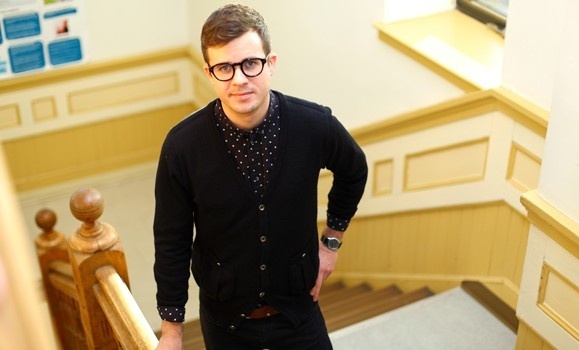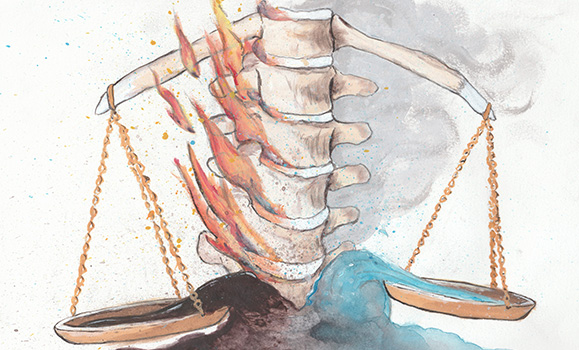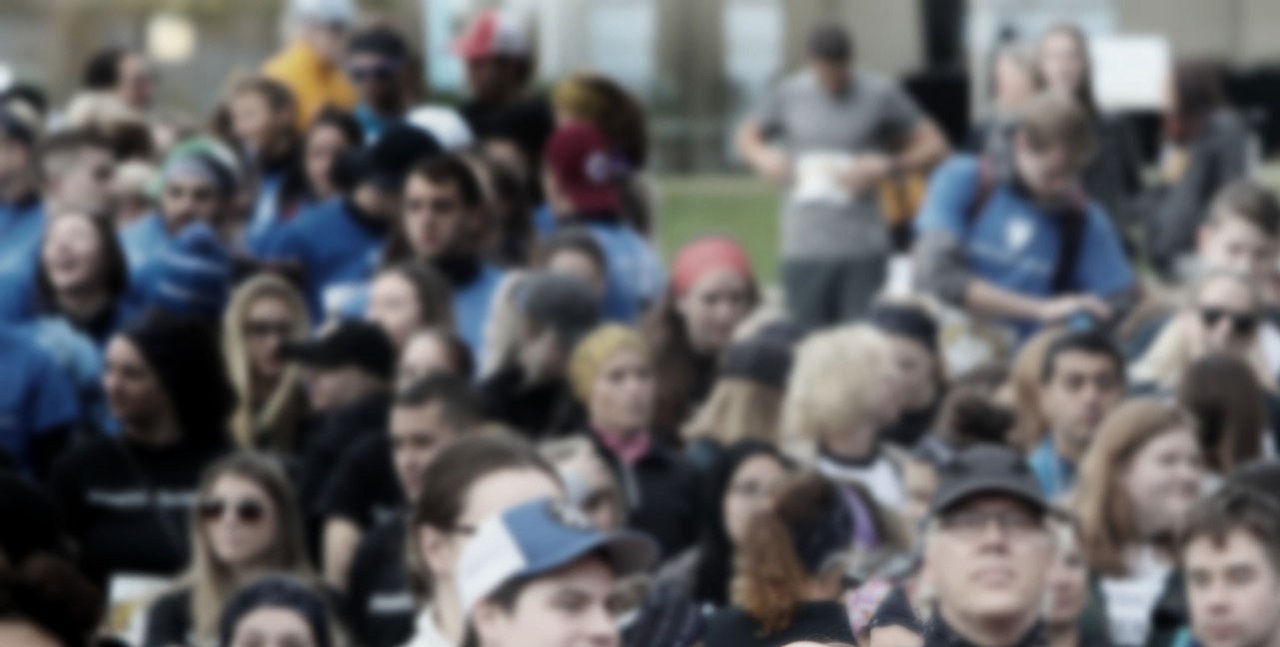News
» Go to news mainExplaining Pain: PhD in Health student changing the way clinicians and patients communicate about lower back pain

Likely, most people reading this have experienced some degree of lower back pain in their lives. Do you remember how your pain was described to you, or what you took away from meeting with your physiotherapist, chiropractor, or doctor? Were you inspired to exercise to help improve your pain, or did you leave the appointment feeling discouraged?
Dr. Peter Stilwell is a fourth year PhD in Health student, supervised by Dr. Katherine Harman (School of Physiotherapy) and Dr. Brenda Sabo (School of Nursing). He is researching how communication between patients with lower back pain and their clinicians can be improved for better outcomes.
Personal experience with pain
Dr. Stilwell spent a lot of his youth skateboarding, leading to his fair share of injuries and appointments with a variety of health practitioners. That sparked his interest in injury management, and wanted to find out why many pain patients didnāt exercise even when prescribed. He completed a Bachelor of Kinesiology at the University of Calgary, the Doctor of Chiropractic Program at the Canadian Memorial Chiropractic College then after clinical practice came to pilipiliĀž» to do a Masters in Rehab Research through the School of Physiotherapy, and a PhD in Health.
An enactive approach to pain
Part of Dr. Stilwellās PhD research is a paper done with Dr. Harman titled .
Dr. Stilwell says he and Dr. Harman challenged the more traditional models, like the Biopsychosocial model, and built on them. The new pain model they propose brings in enactivism, which he says has been applied to depression and other mental health issues but hasnāt been applied to pain in a meaningful way.
āItās very dynamic, it looks at the patient side but also the clinician side, how they interact together, and how that can shape pain for better or for worse. It provides a different route for explaining back pain in a way thatās saying, āitās not all in your head, itās about all of these things integrated together.āā
āWe know that lower back pain is the number one cause of disability worldwide, so it doesnāt kill people, but it can contribute to a lot of suffering, lost work, and frustration. Eighty percent of people are going to experience back pain at one point in their lives. There are other more empowering ways to explain pain and shape a personās path so they are doing more active things, coping with and ultimately reducing their pain.ā - Dr. Peter Stilwell
Listen to Dr. Stilwell and Dr. Harman discuss their research! Podcasts: ,
Ģż
Dr. Stilwell explains that the biopsychosocial model was meant to be dynamic, looking at the biological aspects of pain (joints, discs), the psychological factors (a patientās beliefs/expectations of their pain) and social factors (interaction between patients and the health care system), but somewhere along the line it started getting split up.
āPeople started saying if you canāt find the cause of a personās pain through biological factors, it had to be psychological pain. Our model says thatās a false split. You canāt split them that way, they are all intertwined, and these are artificial circles that have been created.ā
Hearing from patients and clinicians
Dr. Stilwell and Dr. Harman used their new framework to do a study; audio recording real clinical appointments between physiotherapists and chiropractors and their patients. After the appointments, they did individual interviews to find out why the clinician explained things the way they did, and how the patient interpreted it.
They found that certain explanations, such as āyouāre 30 but you have the back of an 80 year oldā could be really discouraging, and make patients feel like there was nothing they could do ā decreasing the chances they would do the prescribed exercises which would help.

(Dr. Stilwell and his wife Christie Stilwell have been turning the metaphors given by patients and clinicians into art. This image represents back pain being like a fire, with subsequent descriptions of adding more water (proactive things) than gasoline (e.g.: sitting all day). Artist: Christie Stilwell)
Dr. Stilwell says one of the better explanations he heard was āmotion is lotionā, which replaces the old saying ārest is bestā and would hopefully motivate patients to exercise.
The teach-back technique is something Dr. Stilwell and Dr. Harman suggest clinicians try with their patients. With this technique, after giving a diagnosis or explanation pain, clinicians ask their patients how they would go home and explain their pain to their spouse/family/friends. If the patient interpreted the message differently than intended, this gives the clinician the chance to tweak their communication accordingly.
International reception
Since publishing their work, Dr. Stilwell and Dr. Harman have been invited to be guests on multiple international podcasts (, ) to discuss their research, and they have heard from clinicians around the world.
āClinical psychologists, physiotherapists, physicians and chiropractors are telling us this is helping guide how they talk and think about pain, and their potential impact on patientsā pain.ā
Dr. Stilwell says there has been a lot of interest from the UK, US, and the Netherlands. To learn from leading scientists and philosophers, he recently attended a training program in Germany for PhD students interested in enactivism. His presentation on this research resulted in further interest from attendees from around the world.
After the research
Now that the study has wrapped up, Dr. Stilwell is taking the metaphors and explanations that were recorded and representing it in art pieces with the help of his wife who just started the PhD in Health program. He hopes to have a gallery showing and bring in the local clinicians involved in the study to see the results, so they can start conversations and clinicians will reflect on their communication style.
Dr. Stilwell plans to continue in this line of research in a post-doc. He says this research has radically changed how he views pain and how he would interact with patients, and heās happy to hear clinicians are saying the same.
Ģż
Recent News
- Lighting the path: Courtney Pennell's mission to support and empower Indigenous nursing students
- Belief in leadership: New Kinesiology course offers lessons from Lasso
- Two Dal Health graduate students heading to the 3MT finals
- Breaking the cycle: Rethinking substance use, stigma, and social inequities in Canada
- Top 10 Dal Health stories of 2024
- Cards for care: Semester three nursing students collect $1,600 for MOSH
- Master of Health Administration grad continuing cancer research in PhD in Health program
- SWABāRx study aims to expand sexual health services in pharmacies
